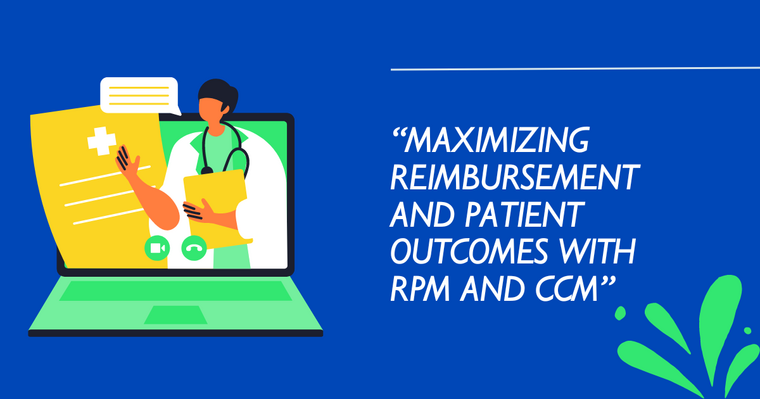
Remote Patient Monitoring (RPM) and Chronic Care Management (CCM) have emerged as pivotal elements in the evolving healthcare landscape. These innovations enhance patient care and offer a sustainable financial model for healthcare providers.
RPM, by allowing patients to be monitored remotely, and CCM, by facilitating continuous management of chronic diseases, together present a comprehensive approach to healthcare. This combination ensures patients receive timely and personalized care, reducing hospital readmissions and improving quality of life.
Moreover, it allows healthcare providers to maximize reimbursement through efficient service delivery. This article focuses on how leveraging RPM and chronic care management services can optimize patient outcomes and healthcare providers' financial gains.
The Significance of RPM and CCM in Modern Healthcare
RPM represents a significant shift in healthcare, leveraging technology to monitor patients outside traditional clinical environments.
It enhances patient engagement by enabling individuals to participate actively in healthcare through regular monitoring.
RPM supports adherence to treatment plans by providing patients with real-time feedback and health data, encouraging them to follow prescribed medical advice closely.
This proactive approach to healthcare can significantly reduce emergency room visits and hospitalizations, as it allows for early detection and intervention.
By reducing the need for in-person visits, RPM offers substantial cost savings for patients and healthcare providers, making healthcare more accessible and efficient.
Implementing RPM technology highlights the evolving nature of healthcare delivery, focusing on preventive care and continuous monitoring.
Chronic Care Management (CCM):
CCM focuses on the comprehensive management of patients with chronic conditions, adopting a holistic approach to healthcare.
It involves coordinated care strategies that integrate education, regular monitoring, and the development of personalized care plans tailored to each patient's unique needs.
By addressing the root causes and symptoms of chronic conditions, CCM aims to improve overall patient health outcomes.
The personalized care plans in CCM are designed to enhance the quality of life for patients by providing continuous support and guidance.
CCM's focus on education empowers patients to understand their conditions better and manage their health more effectively.
This model of care emphasizes the importance of a collaborative relationship between healthcare providers and patients, making chronic condition management effective.
Maximizing Reimbursement through Effective Implementation
For healthcare providers, integrating RPM and CCM into their services is not just about improving patient care but also about financial viability. Medicare and other insurance programs increasingly recognize the value of these services and offer reimbursement models that reward providers for their implementation.
To maximize reimbursement, providers must ensure their RPM and CCM programs are aligned with payer guidelines and demonstrate measurable improvements in patient health outcomes.
Key strategies include:
Documentation and Compliance: Rigorous documentation of RPM and CCM services is crucial. Providers must maintain detailed records of patient interactions, monitoring data, and care plan adjustments. Compliance with billing codes and payer requirements is also essential to secure reimbursement.
Patient Engagement: Engaging patients in their care through RPM and CCM improves health outcomes and supports reimbursement claims. Providers should invest in patient education and communication tools, encouraging active participation in these programs.
Technology Utilization: Investing in the right technology is vital for the success of RPM and CCM programs. Providers should choose platforms that are user-friendly, reliable, and capable of integrating with existing health records systems. This ensures seamless data collection and analysis, supporting patient care and reimbursement.
The ultimate goal of RPM and CCM is to improve patient outcomes. By enabling early detection of potential health issues and providing continuous, personalized care, these programs significantly manage chronic conditions and prevent complications.
Improved Quality of Life: RPM and CCM empower patients to take an active role in their healthcare, leading to better management of their conditions and an improved quality of life.
Reduced Hospitalizations: Continuous monitoring and management can prevent the escalation of chronic conditions, reducing the need for hospital admissions and readmissions.
Patient Empowerment: With access to their health data and ongoing support from healthcare providers, patients feel more in control of their health, increasing satisfaction and adherence to treatment plans.
RPM and CCM represent a paradigm shift in healthcare delivery, offering a pathway to improved patient outcomes and financial sustainability for providers. By embracing these technologies and aligning them with reimbursement models, healthcare providers can enhance the quality of care and secure their financial future.
Integrating RPM and CCM into healthcare practices demands a strategic approach, focusing on patient engagement, compliance, and technology utilization. As the healthcare industry continues to evolve, those who effectively implement these programs will be well-positioned to deliver high-quality, patient-centered care.
|
|